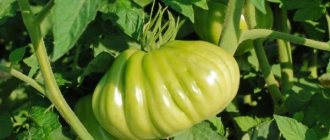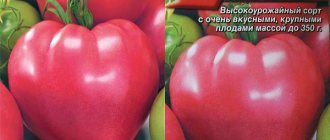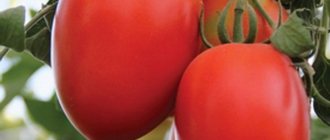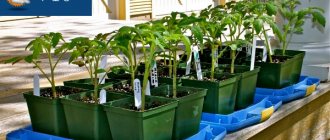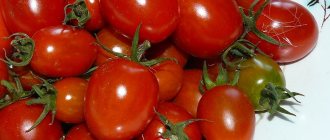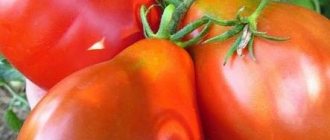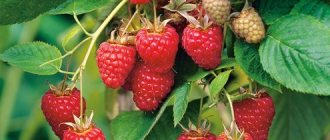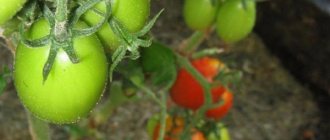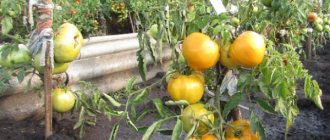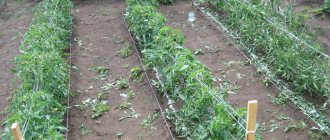Tomatoes of the “Red Banana” variety were bred more than 20 years ago, but are still highly valued by gardeners. They can be grown in different climatic conditions, have high commercial qualities and are suitable for transportation over long distances. You will learn about other positive qualities and methods of growing the variety in this article.
Red Banana Tomato Seeds
Red banana tomatoes
Banana red tomatoes can reach up to 12 cm in length
Description and characteristics
Below is a detailed description of the most significant parameters of a tomato.
Fruit
Have characteristics:
- Form. Elongated, resembles a cylinder. There is a slight rounding at the tip of the tomato.
- Length. The largest fruits reach 12 centimeters. But on average they grow up to 7 cm.
- Weight. Large. 1 average fruit can weigh 100 g.
- Color. Vegetables have a rich red color.
- Seeds. Located in 3 separate chambers.
- Skin. Elastic to the touch, dense, rarely cracks. Sometimes it feels rough.
- Pulp. It has a dense structure and medium juiciness.
- Taste. Expressed to a medium degree, a little bland.
Plants
The following is typical:
- Height. Low growing plant. The bush can reach a maximum of 120 cm.
- Ovary. The first one is formed above the level of the 8th sheet. Further, stems grow back every 2 leaves.
- Inflorescence. Up to 12 flowers are formed on each brush. Therefore, the fruits usually form clusters.
Productivity
What is known about it:
- Maturing period. Belongs to varieties of early ripeness. The first harvest can be obtained within 105 days after planting the seeds. After another 14 days, the mass harvest begins. Thanks to this, the variety can be grown in the middle zone and northern regions.
- Productivity. From 1 bush per season you can get about 30 fruits (3 kg).
- Collection period. The variety bears fruit until November.
Application
You can use Banana Red for:
- pickling and preservation;
- drying;
- making various sauces;
- eaten fresh or in salads.
Due to the variety's resistance to long-distance transportation, it can be used for sale.
The juice from the fruit is very thick and not to everyone’s taste.
The main characteristics of this variety and the appearance of the seeds are described in more detail in the video presented:
Varieties and types
The characteristics of the Red Banana variety turned out to be so successful that breeders created several more varieties with different skin colors. Taking into account the wishes of vegetable growers, new varieties have greater growth and, accordingly, higher yields. They are intended for greenhouses, but they also bear fruit well in the open air.
- The yellow Banana tomato is the “heaviest”, having a fruit weight of 150 g. It also has a delicate and thin skin. The taste is sweet and sour, the flesh is juicy. Its height reaches 2.5 m. Up to 11 tomatoes ripen in each fruit bunch. Ripening is medium late (120-127 days from the appearance of seedlings). Productivity is 7-8 kg per plant when grown indoors.
- Golden Banana is slightly smaller than yellow banana, its weight is 110-130 g. The taste is sweetish and pleasant. The color of the skin is yellow-orange. The plant grows up to 2 m, producing 6-8 clusters. Each brush contains 7-10 fruits. Productivity up to 5 kg per plant.
- Pink banana produces fruits weighing 100-110 g. They are sweet, fleshy, with a strong skin. The height of the tomato stem is 150 cm. It requires mandatory pinching and tying to a support. Productivity up to 4 kg per plant.
- The variegated banana has the most original coloring of the fruit: red strokes and stripes are densely scattered on an orange background. Such varieties are called “bicolor” because they combine 2 colors. Tomato weight is from 80 to 120 g. The pulp is dense and does not become limp in the marinade. The taste is sweet and sour. The variety is intended for planting in a greenhouse and has unlimited growth. The harvest is ready for harvest 4 months after sowing. Productivity – from 3 to 6 kg per plant.
See also How to prepare tomato seeds for planting as seedlings
On a note. If you plant plants with fruits of different colors in your area, you can prepare elegant salad mixes, combining multi-colored tomatoes in a plate.
Growing methods
There are 2 main ways to grow red tomatoes:
- In the greenhouse. The soil in the greenhouse must be fertilized with the necessary minerals. Good humidity and lighting should be provided. It is advisable to maintain the temperature at least 20 degrees. To enrich the air with oxygen, you need to open the greenhouse doors wide open 1-2 times a week.
- In open ground. Planting in open ground should be carried out in the warm season when there is no risk of frost. Most often they choose May. It is advisable to prepare the soil in the fall; for this you need to fertilize it well.
Carrots, cucumbers and cabbage are suitable as predecessor crops.
Growing vegetables of the Red Banana variety takes several stages.
Preparing and planting seeds
Before planting, you must prepare the seeds to ensure their good germination. This is done like this:
- Sorting. Carefully sort out all the seeds so that there are no empty or small ones.
- Washing. Rinse the seeds thoroughly, after which they can be dipped in a very weak solution of potassium permanganate for 1/4 hour, after wrapping them in a clean gauze cloth. This will help protect the sprouts from pests.
- Germination. Wrap the seeds in gauze moistened with warm water and put them in a well-lit place. They should be wetted daily. As soon as the sprouts appear, you can start planting.
Seedling
To plant seeds for seedlings you need:
- Prepare the soil. To do this, cover the bottom of a plastic container with drainage. Place soil on top of it.
- Disembarkation. Make small holes in the soil (no more than 1 cm). Place change in them, which you then sprinkle with soil.
- Watering. The water should be slightly warmer than room temperature.
- Germination. To insulate the plants, cover the container with a thin film. Regular watering is required.
- The appearance of sprouts. At this time, remove the film and move the container with the plants to the window closer to the sun.
- Picking. After 2 true leaves appear. Transplant each sprout into a separate container, for example, a peat pot.
- Hardening. 2-3 weeks before planting in the ground, take the plants out into the open air during the day. Start with a few minutes, gradually increasing this time. A week before planting, stop watering the seedlings.
It is best to replant a tomato into the ground on the 55th day after planting the seeds.
Purchased seedlings
If you don’t want to grow seedlings yourself, you can buy them. When buying seedlings, pay attention to:
- Plant height. Should be up to 30 cm.
- Healthy looking. The leaves should not look drooping, yellowed, deformed, spotted, or show signs of pest infestation.
You can recognize an excess of nitrogen fertilizers, which unscrupulous sellers use for more intensive seedling growth, by the bright green leaves curled inward.
- Stem. The shoot must be strong and thick. It should develop 10 leaves.
- Roots. Without defects, well developed.
Planting plants in the ground
Transplant seedlings into open ground according to the scheme - 50 by 60 cm. Per 1 sq. m there are 3-4 plants. Plant seedlings in the prepared holes and cover with soil. Water the plants well.
The method of planting in a greenhouse is no different from planting in a garden bed.
Sowing seeds
In the southern regions, seeds can be sown immediately in the ground. Carry out the work in the following sequence:
- in the prepared bed, dig holes 1.5 cm deep, following the pattern as for planting seedlings;
- Pour warm water into each well and let it soak;
- put 4-5 seeds in each hole and cover with soil;
- create a mini greenhouse by covering each hole with a jar or cut plastic bottle;
- Place the frame over the rows and stretch the film over it.
Care
The following are basic recommendations for caring for tomatoes of the “Red Banana” variety.
Bush formation
Plants form into 2 stems. In order for the bushes to develop well, they need to be tied to a support in the form of a wooden or metal post.
When tying up plants, do not overtighten them, otherwise fruiting will not occur.
To prevent the plant from growing too much, regularly remove excess shoots by hand. It is recommended to do this in the morning, when there is no risk of sudden precipitation. Before this, the plants are not watered or fertilized. It is better to carry out work wearing thin gloves. Treat the broken area of the stepson with ash.
Top dressing
At the beginning of the season, enrich the soil with nitrogen and add organic fertilizer. Regular manure or ash will do.
During the period of active growth, fertilize at least 3 times using complex fertilizers (Nanovit, Mivena).
When the plant begins to bear fruit, use fertilizers containing magnesium and potassium.
Weeding and loosening
After watering, be sure to weed the garden bed to prevent the growth of weeds.
Using sawdust, hay or sunflower husks mixed with soil, you can create a protective layer around vegetables. It will retain moisture and prevent weeds from growing. More about soil mulching is written here.
Loosening is best done immediately after watering or precipitation.
Watering
While the ovaries are not yet formed, water the plants every day. After this, you can limit yourself to 1-2 waterings per week.
If the plant is grown in open ground, during the rainy season avoid watering altogether.
Characteristics of tomato Red Banana
This variety is an early ripening variety, since the fruits have time to form 3-3.5 months after the seedlings emerge. At this point they become technically ripe, after which they arrive within 15-17 days. To speed up ripening, tomatoes can be picked and placed in a dark place. Fruiting is uniform, the main wave occurs in the second half of July. At the same time, in heated greenhouses, the harvest can be harvested until the beginning of November.
Tomato yield Banana red and fruiting
Red banana is a fairly productive tomato (for determinate varieties). From one bush you can remove 3-4 kg of tomatoes, while the yield of marketable fruits, according to the State Register, is 2.5-3 kg.
| Growing method | In the greenhouse | In an open garden |
| From 1 bush, kg | 3-4 | 2,5-3 |
| From 1 m2, kg* | 12-16 | 10-12 |
*Since the bushes are not very spreading, 4 plants can be planted per 1 m2. If you grow 3 stems, 3 bushes will fit in the same area.
Maximum yields can be achieved by growing Red Banana tomato in greenhouse conditions. In addition, it is necessary to follow the basic rules of agricultural technology:
- Regular watering.
- Application of complex fertilizer.
- Ventilation of the greenhouse.
- Forming a bush with 2 or 3 stems.
- Step-sonning - as needed.
- Mandatory tying of bushes to a support.
Area of application of fruits
Tomatoes of this variety have a universal purpose. They are good fresh and used in various dishes and preparations:
- soups;
- sauces;
- tomato paste;
- ketchup;
- adjika;
- lecho;
- vegetable caviar.
Due to their small size and thick skin, Red Banana tomatoes are ideal for canning in their entirety (pickling, pickling). However, due to their low juiciness, they are not suitable for making tomato juice. On the other hand, such tomatoes can be dried.
Red Banana tomatoes are great for drying
Resistance to diseases and pests
Tomatoes of this variety are characterized by average resistance to such common diseases as tobacco mosaic and fusarium, but they have good immunity to cladosporiosis. Summer residents note that in rainy weather the bushes may suffer from late blight. To prevent this, you need to follow simple preventive measures:
- Constantly ventilate the greenhouse, especially after watering.
- Monitor moderate amounts of watering - the soil should not be too wet.
- Treat the bushes with fungicides at the seedling stage (early May).
- Periodically inspect for insects. If traces are found, wash off the pests with water and treat the plants with insecticides or home remedies.
Sustainability
It is worth mentioning separately the sustainability of tomatoes of this variety.
To external conditions
"Banana red" can be grown in different climatic conditions as it has good resistance to climate change. Formed plants tolerate heat and cold well.
To diseases and pests
Among the main problems that can affect Banana Red are:
- Cladosporiosis. Occurs when the permissible air humidity level is exceeded. It appears as yellow spots covering the surface of the leaves. The reverse side is covered with a grayish coating. As the pathology progresses, the leaves wither and their color turns brown. To prevent the development of the disease, observe the necessary growing conditions, and also spray the leaves with weak garlic or iodine solutions. You can cure plants by purchasing preparations containing copper.
- Late blight. It may appear if it rains for a long time or there are frequent climate changes. The main sign of the development of the disease is the appearance of dark brown spots on the leaves and fruits of tomatoes. The disease can be prevented by taking precautions when pruning shoots or by sprinkling the plants with a weak salt solution. Treatment is carried out with the drug "Fitosporin".
- Fusarium. It is a fungal disease. Develops due to improper planting or lack of lighting. First of all, the tomato leaves turn yellow and curl into tubes. The plant begins to wilt. The last thing to die is the root system. The plant rots and soon dies completely. Symptoms are more severe in hot weather. To prevent disease, treat the soil for planting with a solution of copper sulfate. Plants can be cured using the drug Trichodermin, but this must be done as early as possible.
- The tomato is moderately vulnerable to pests, one of which is whitefly. To protect plants from parasites, treat them with insecticides at the first sign of damage.
For preventive purposes, treat every 14 days after the formation of ovaries.
Collection and storage of tomatoes
There are several rules to consider:
- To store vegetables for a longer period of time, tear them off along with the stem;
- pick tomatoes when they are not fully ripe, they will ripen well in the sun;
- Wooden boxes are suitable for storage;
- To ensure safe transportation, place the vegetables in separate rows.
Under favorable conditions, vegetables can be stored raw for up to 150 days.
Advantages and disadvantages
As a generalization, we can list the main advantages of the variety:
- Unpretentiousness. "Banana red" can be grown in different climate zones throughout Europe. Ideal for cultivation in northern regions.
- Immunity. In addition to those listed, tomato is resistant to most diseases.
- Germination. Most seeds germinate after planting.
- Resistance to transplantation. If the necessary conditions are met, the plants take root well.
- Good yield. You can harvest up to 15 kg of tomatoes from 1 sq. m. Moreover, external growing conditions do not affect the yield in any way.
- Commercial qualities. Tomato fruits have almost the same size and shape. They retain their appearance and taste even during long-term storage.
But you should also pay attention to the disadvantages:
- The nutritional value. Tomatoes are not juicy and tasty enough and are unsuitable for many dishes.
- Difficulties in growing. You need to form the bushes yourself and constantly ensure that the plant does not grow.
- Instability to humidity. In conditions of high humidity, plants become vulnerable to fungi.
Advantages and disadvantages
Based on the description of the variety, we can draw a conclusion about the advantages and disadvantages of its cultivation.
- Advantages of the variety:
- gives a good early harvest;
- can be stored for up to 3 months;
- ideal for canning and pickling due to its compactness and dense peel;
- has an excellent presentation;
- not susceptible to diseases.
- Disadvantages of the variety:
- modest taste when fresh;
- not recommended for juices;
- low immunity to fungi;
- Depending on the height of the bush, pinching may be required.
Reviews
The most informative reviews:
★★★★★
Elena, 48 years old. I have been growing banana tomatoes for almost 7 years.
For me they are ideal in taste and appearance. Previously, I only grew it for myself, but now I also take it for sale. While I’m taking it from the dacha, the skin is not damaged, the fruits are not crushed. The tomatoes are beautiful and neat, have an ideal presentation. ★★★★★
Ivan, 61 years old. I recently purchased red banana seeds.
Immediately after harvesting, I was dissatisfied - the taste seemed too bland to me. But then my wife suggested we dry them. The result was simply excellent; now I will only grow this variety for drying. ★★★★★
Maria, 52 years old. I like that “Red Banana” is quite unpretentious.
It’s cold in our region, so not all varieties can be grown, but this one grows well and also produces a good harvest. I use it to make tomato paste and store it for the winter. Good variety. Hide
Add your review
Not everyone will like Banana Red. First of all, it is suitable for cultivation in northern regions. The plants are unpretentious, resistant to many diseases, and are an ideal option for drying and preservation. But still, their nutritional value is considered average due to their bland taste and unsuitability for making juices.
0
0
Copy link
Reviews about the variety from those who planted
Judging by numerous reviews from summer residents and gardeners, varietal tomatoes “Yellow Banana” are tomatoes with special taste. The unusual shape and color of the fruit adds piquancy to home-preserved fruits. Tomatoes are rich in nutrients, vitamins and amino acids, and can be eaten by people who suffer from allergic reactions to regular tomato varieties.
Read also: Clematis isago photo description
Among the yellow-fruited tomato varieties, it is impossible not to mention the Banana Yellow tomato, which received its name due to the characteristic shape and color of the fruits - elongated, bright yellow with a small spout at the end.
| Height | Landing location | Ripening time | Fruit color | Fruit size | Origin | Fruit shape |
| Tall | Greenhouse | Mid-season | Yellow | Average | Variety | With spout |
